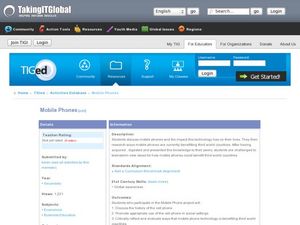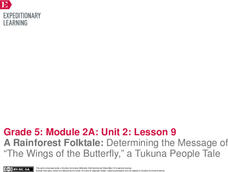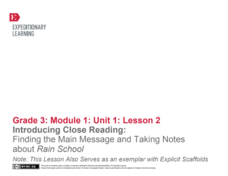Statistics Education Web
Who Sends the Most Text Messages?
The way you use statistics can tell different stories about the same set of data. Here, learners use sets of data to determine which person sends the most text messages. They use random sampling to collect their data and calculate a...
Statistics Education Web
Text Messaging is Time Consuming! What Gives?
The more you text, the less you study. Have classes test this hypothesis or another question related to text messages. Using real data, learners use technology to create a scatter plot and calculate a regression line. They create a dot...
Curated OER
Lesson: Text Messages
Can a neon sign be considered art? Kids consider two different works that use neon text as the basis for conveying artistic social messages. They then analyze a truism from Jenny Holzer's web site that holds meaning to them personally....
Humanities Texas
Primary Source Worksheet: Thomas Jefferson, Message to Congress on the Embargo
Zounds! Image an American president closing all ports and prohibiting exports. As part of an exercise designed to strengthen primary source comprehension skills, readers examine Thomas Jefferson's 1808 message to Congress urging such an...
Curated OER
Text Messaging Tales
In this reading and writing worksheet, students read the text messages sent between 2 friends. Students complete a 4 part story showing what happens in between each set of text messages.
Curated OER
Find The Hidden Message: Media Literacy in Primary Grades
Learners practice listening to and reading various types of media and text. In groups, learners use video, newspapers, magazines, and more to compare and contrast different types of information. They identify the differences between fact...
Curated OER
Generation TeXt
Students write sentences using different writing styles. Through peer editing, they hone their writing to create effective thesis statements. They create a glossary of text messaging terms.
Google
Friends: Texting Story
Sometimes it's okay to text in school. Young computer scientists work in the Scratch program to write a text message conversation among friends. They use different sprites within the program to represent each side of the conversation to...
Ontario
Reading Graphic Text
Do learners really need to be taught how to read cartoons, comic books, and comic strips? Yes. Just as they need to learn how to read other forms of graphic text such as diagrams, photos, timetables, maps, charts, and tables. Young...
Curated OER
Using Words: Verbal Communication
Written and verbal communication is the topic for today. The class goes over various facets of verbal communication, such as plain English, active voice, passive voice, cliché, and jargon. They then use those devices as they discuss...
Curated OER
Texting for all
Students examine the language and punctuation marks associated with text messaging. They take a pre-quiz to determine their knowledge of texting language, practice reading and writing messages and determine appropriate uses for text...
Curated OER
TEXT MESSAGING
Students examine the differences between standard and non-standard English and use text-speak to rewrite a plot summary and a news story. They identify a type of non-standard English and determine the characteristics that make it...
Code.org
Encoding and Sending Formatted Text
Introduce your class to encoding text. Pairs work together to create a protocol to send text prior to learning ASCII encoding. Groups then collaborate to send and translate ASCII codes creating a formatted text message.
Code.org
Text Compression
The second lesson in a unit of 15 introduces pupils to text compression. The class begins with discussing how they already use text compression when sending text messages. Pairs learn more about the subject as they work to compress a...
Curated OER
Making an Inference from an Implied Message Within a Text
Show your scholars that they make inferences every day and might not even know it. Through scaffolded instruction, they break down the process of drawing information from context. Using example sentences and didactic questioning,...
K12 Reader
Summarize It: President Theodore Roosevelt's 7th Annual Message to Congress
How did Theodore Roosevelt stress the importance of conservation during his time as president of the United States? Take a closer look at the language Roosevelt used himself in a 1907 address to Congress, and have your young historians...
Curated OER
Mobile Phones
Mobile phones and how they are used is the focus of this sociology lesson. In it, middle and high schoolers explore how they use mobile phones. They create and act out conversations, text messages, and take a close look at how texting is...
Nemours KidsHealth
Obesity: Grades 9-12
High schoolers take on the role of the nation's first Teen Nutrition and Fitness Czars and create tips that can be texted to other teens to remind them about healthy eating and exercising. Groups read articles to gather background...
Curated OER
Determining Author's Point of View: The Sneeches
Determine the author's point of view in a text. Young readers read Dr. Seuss' The Sneeches and identify the author's purpose in the story. They identify persuasive techniques in writing, asking and answering questions to better...
EngageNY
A Rainforest Folktale: Determining the Message of “The Wings of the Butterfly,” a Tukuna People Tale
Did you the message? Scholars listen to a read aloud of The Wings of the Butterfly to summarize and determine the message of the text. They discuss the folktale and vocabulary in groups, then use a double bubble map to compare the story...
Humanities Texas
Primary Source Worksheet: Thomas Jefferson, Message to Congress Concerning Louisiana
Proficient reading of informational text, especially primary source documents, requires practice. This message from Thomas Jefferson about the Louisiana Purchase offers readers a chance to develop these comprehension skills.
Read Works
How to Say “I Ruff You”
Who says you need a human to be your valentine on Valentine's Day? Give your dog-loving readers an inspiring perspective on how a sister givdes her brother a valentine from the family dog. They then answer 10 questions thatd involve...
EngageNY
Introducing Close Reading: Finding the Main Message and Taking Notes About Rain School
This second instructional activity in a larger unit is perfect for the beginning of the year because it explicitly teaches 3rd graders how to use close reading skills by identifying unfamiliar words, figuring out the gist, and defining...
Student Achievement Partners
"The Glorious Whitewasher" from The Adventures of Tom Sawyer by Mark Twain with Mini-Assessment
It's the classic scene: Tom Sawyer is whitewashing a fence. Expose your learners to Mark Twain's humor while reinforcing reading comprehension. Eighth graders are encouraged to read and reread, achieving as much exposure to the text as...
Other popular searches
- Decoding Text Messages
- Esl Text Messages
- Text Messages Sms
- Writing Text Messages
- Text Messages Sims
- Journalism and Text Messages

























